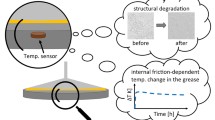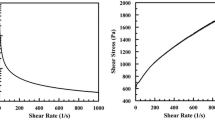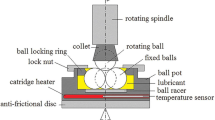Abstract
A comprehensive study of the yield stress and start-up torque for six commonly used rolling bearing greases is presented. Both parameters were found to depend exponentially on temperature where the exponent changes below a low-temperature “break point.” This break point was found to be related to the pourpoint of the base oil, although the start-up torques of the greases were an order higher in magnitude than that of their corresponding bled oils. The start-up torque is mostly used to measure the low-temperature limit of a grease. It was found here that this temperature is much lower than the break point. The start-up torque criterion is measured using a particular bearing type and conditions. The low-temperature break point for the yield stress is a more universal grease parameter that gives useful information about the behavior of a grease at low temperatures and can be used as one of the guidelines for grease selection for low-temperature applications.
Similar content being viewed by others
1 Introduction
Lubricating greases are structured materials consisting of a dispersion of thickener within a suitable base oil [1]. The performance of the lubricating grease in rolling bearings depends strongly on the grease rheology, internal bearing geometry, and transient operating conditions. At very low temperatures, the grease may become so stiff that it causes high resistance to the motion of the rolling elements [2]. This may lead to skidding, damaging the bearing. The stiffening will be different for different greases, which is translated into a so-called low-temperature limit (LTL) below which a bearing should not be operated. Measuring the onset of damage is very difficult. Therefore, in practice the start-up torque is used as a criterion for grease stiffening. The LTL is then defined as the temperature at which the start-up torque exceeds a predefined value of say 1000 mNm in a standardized test setup [3].
Lubricating greases are viscoelastic materials up to a yield point where plastic deformation occurs. Earlier work suggests that the start-up torque is related to the shear stress experienced by the grease during start-up and is related to the yield stress [4, 5]. Edmund [5] showed that there is a linear relation between start-up torque and yield pressure for lubricating greases. Kobzova et al. [6] also assert the importance of the yield stress on the start-up torque.
In an earlier paper [7], the authors studied the temperature dependence of the yield stress from oscillatory strain sweep measurements for six greases that represented the most commonly used thickener—oil systems. The same greases were employed in this study (Table 1). At a temperature below zero degrees Celsius, a deviation from “Arrhenius behavior” was observed for those greases based on mineral and semisynthetic oil [7]. A “break” in the Arrhenius plot characterized by a change in slope is known to be caused by a change in phase, as shown by Kumamoto et al. [8] for biological systems. This change in slope causes a rapid increase in yield stress below a critical temperature.
In this study, yield stress measurements were taken over a wider range of temperature than in [8], and these measurements will be compared to the start-up torque. It will be shown that the “break” in the Arrhenius plot can be associated with the pourpoint of the bled oil. The low-temperature break is a grease parameter and, other than the LTL, not measured with a particular bearing. Therefore, it gives useful general information on the behavior of a grease at low temperatures which is generally applicable to any bearing.
2 Materials and Methods
2.1 Tested Greases and Bled Oils
Six greases formulated from the most common thickeners and base oils were tested (Table 1). The bled oils were extracted from the greases by using Heraeus Biofuge 17RS centrifuge [9].
2.2 Rheological Characterization
Rheological characterization was carried out using oscillatory strain sweep. These measurements were taken on a controlled strain rheometer (MCR 501, Anton Paar) using sandblasted parallel stainless steel plate geometry (R a = 2.87 µm, R = 12.5 mm and 1 mm gap setting). The oscillatory strain sweep measurements were taken using a strain ranging from 0.001 to 1000 % at a frequency of 1 Hz. A relaxation time of 20 min was considered sufficient for the sample to relieve the residual stress, before taking the measurements. Experiments were carried out in the temperature range of −50 to 50 °C and at a precision of ±0.5 °C. The measurements were found to be reproducible with a maximum error of ±5 %.
2.3 Start-Up Torque Measurements
The start-up torque of the lubricating greases and corresponding bled oils were measured using a controlled strain rheometer (MCR 501, Anton Paar) fitted with tribology cell T-PTD 200 (Fig. 1a). The measurements were taken using the IP 186 standard testing procedure in the temperature range of −30 to 50 °C. An axially loaded angular contact ball bearing with detachable outer ring (SKF 7204 BEP), rotating at 1 rpm, was used.
After loading the weighted quantity of grease as per the IP 186 standard, pre-shearing was performed to achieve a uniform distribution of grease inside the bearing. The pre-shearing was carried out using oscillatory strain sweep, and the test conditions are summarized in Table 2. This was analogous to manual pre-shearing in the IP 186 standard. The measurements were found to be reproducible with a maximum error of ±10 % (Fig. 1b). After pre-shearing, a relaxation time of 20 min was allowed before performing the torque measurements.
The start-up torque measurements were taken at an axial load of 44.1 N for a duration of 60 s and at a sampling frequency of 50 Hz. Temperature control was achieved using a Peltier device offering a precision of ±0.1 °C. The maximum error associated with the measurements was found to be ±12.5 %.
2.4 Pourpoint Measurements
The pourpoint of the bled oils was obtained using the ASTM D 97 standard test procedure. In this test, the specimen in a jar is cooled and periodically examined for any movement of oil for every 3 °C decrease in temperature. The pourpoint is obtained by adding 3 °C to a temperature corresponding to “no flow” when the jar is held horizontally for 5 s.
3 Results
3.1 Rheological Characterization
In an earlier paper, the authors studied the yield stress of the same greases as used in this study, using various techniques [7]. They preferred oscillatory measurements over continuous shear for estimating the yield stress as the preceding method was found to be less sensitive to wall slip. The viscoelastic properties of the lubricating greases can be quantified using storage (G′, elastic component) and loss modulus (G″, viscous component). Below a critical strain amplitude (γ cr), the structural integrity of the network is maintained, and the material parameters (G′ and G″) are found to be independent of the imposed strain (Fig. 2a). However, above γ cr, higher strain energy may cause structural damage. As a result, both G′ and G″ decrease and the material behaves as if it is a liquid. However, for lubricating greases, there is no sharp transition from solid- to liquid-like behavior. As a result, the yield stress is defined here as the stress corresponding to a predefined (0.5 %) deviation from the linear relation between stress and strain (Fig. 2b). In rolling bearings, the timescale of the flow problem varies. So, the prediction of yield stress should ideally take place over a wide frequency range. It was shown earlier that the yield stress varies linearly with the imposed frequency. In this study, an arbitrary frequency of 1 Hz was chosen.
3.2 Temperature Dependency of the Yield Stress
The yield stress versus temperature on a semilog scale is shown in Fig. 3. The yield stress was found to exhibit Arrhenius behavior, i.e., it varies exponentially with temperature. The yield stress versus temperature is conveniently written as:
where τ y0 is the yield stress at temperature T = T 0.
In this equation, the yield stress halves for a temperature increase of ΔT = b. This is more practical than using an activation energy and gas constant. The parameter, “b,” obtained using Eq. (1) is listed in Table 3.
A significant deviation from Arrhenius dependency was exhibited by all the grease samples when cooled below a certain temperature, characterized by a “break” in the curve. The temperature corresponding to the “break” is here termed T b. Below this temperature, a second exponential constant b was found to apply where the sensitivity to a change in temperature is much larger for all greases (Table 3). Another important observation is the much lower T b for greases based on PAO and ester oils in comparison with those based on mineral oil.
3.3 Start-Up Torque Measurements
Figure 4 shows a typical plot for torque versus time for both grease and corresponding bled oil. It illustrates the problem that occurs with a grease lubricated bearing at very low temperature: The torque is much higher than that of an oil lubricated bearing. This is ascribed to the higher churning resistance caused by the grease. In the following section, only the start-up torque will be addressed.
3.4 Temperature Dependency of the Start-Up Torque
The start-up torque for all greases was found to be an order higher in magnitude than for the corresponding bled oils (Fig. 5). However, an exception can be seen for CaS/M, for very low temperature. Similar to the yield stress, the start-up torque was also found to exhibit Arrhenius temperature behavior with a “break point.” The variation in start-up torque versus temperature can again be fitted using Eq. (1), and the parameter “b” obtained is shown in Table 4. The transition to high torque behavior (the break) is observed at a much lower temperature for PAO and ester-based greases in comparison with mineral oil-based greases. The “break” for PAO and ester oils probably occurs at temperatures lower than those that could be measured on the present system.
The variation in start-up torque with temperature was found to be different for greases and their bled oils, shown by different values of “b” (Table 4). The greases exhibited a lower variation in start-up torque with temperature in comparison with their bled oils. A larger variation in bearing friction torque to changes in temperature is exhibited by PAO and ester oil, given by lower values of “b” in comparison with the mineral oils studied (Table 4).
3.5 Start-Up Torque Versus Yield Stress
The start-up torque versus yield stress plots for the studied greases are shown in Fig. 6. The figure shows that there is a linear relation between start-up torque and yield stress. Similar to yield stress—temperature and start-up torque—temperature, also the start-up torque—yield stress relation shows a break. This break was found to occur at temperatures close to the pourpoint of the bled oil, with the exception of polyurea grease (Fig. 6).
4 Discussion
There is a linear relation between start-up torque and yield stress. However, this relation is not unique. It is different for different greases. This means that the temperature dependence of yield stress and start-up torque is similar, which is reflected in quite similar values for “b” (see Tables 3, 4). The relationship changes at a characteristic temperature giving two temperature domains with different temperature dependence. This characteristic temperature, the “break point” in the Arrhenius plots (T b), is correlated to the pourpoint of the bled oil (Fig. 7a; Table 5). So the change in temperature behavior is mainly ascribed to the temperature where the base oil loses its flow characteristics. The bled oil pourpoint and the “break” in the start-up torque with grease (Fig. 7b) and bled oil are less good correlated, which may be attributed to the fact that the start-up torque is not only governed by the yield stress.
The torque corresponding to the “break” (T b) was not found to be comparable to the LTL, as for none of the lubricants, the start-up torque was found to exceed the often used limit of 1000 mNm. The LTL according to this definition is much lower than the break point, and the yield stress will be extremely high at this point. The break point is a valuable grease parameter though. Greases with low values for the break point are more suitable for operation at very low temperatures.
The much lower T b for greases based on PAO and ester oils in comparison with mineral oil-based greases confirms that PAO and ester-based greases can be used at lower temperatures than mineral oil-based greases.
5 Conclusions
The yield stress and start-up torque characteristics of six greases formulated with the most common thickeners and base oils have been studied in this paper. The start-up torque of the greases was found to be an order higher in magnitude than that for their corresponding bled oils. For rolling bearings operating at medium temperatures and medium speeds, the running torque is mainly given by the base oil viscosity of the grease. This clearly does not apply to the start-up torque, which is generated by the resistance of the balls to travel through the grease rather than the shear in the EHL contact. A deviation from Arrhenius behavior was observed for yield stress and start-up torque at lower temperatures, characterized by a “break.” The “break” was found to occur at a temperature close to the pourpoint of the bled oils. There is a linear relation between the start-up torque and the yield stress of the grease which indicates that the temperature dependence of the yield stress and start-up torque is similar. This linear relation changes at a temperature close to the pourpoint of the bled oil. At even lower temperatures, there is again a linear relation between start-up torque and yield stress, but now with a different slope. The change in slope is ascribed mainly to the phase change in the base oil (the oil loses its flow properties) occurring at this temperature.
There are indications that the LTL, i.e., the lowest temperature at which a bearing can be started up without causing damage to a bearing, is much lower than the break point. This break point or pourpoint of the base oil can therefore not be used as a measure of the LTL. This does not mean that the break point or pourpoint of the base oil is not relevant. Greases with a low break point will also have a low LTL.
The fact that the break point is related to the pourpoint of the base oil is illustrated by the very low pourpoints of PAO and ester oils which can be used at lower temperatures than those greases based on mineral oils.
Abbreviations
- b :
-
Arrhenius parameter
- D :
-
Diameter of the thickener particle (m)
- F N :
-
Normal load (N)
- ω :
-
Frequency (Hz)
- G′ :
-
Elastic modulus (Pa)
- G″ :
-
Loss modulus (Pa)
- L :
-
Length of the thickener particle (m)
- R :
-
Radius of the parallel plate (m)
- R a :
-
Roughness parameter (m)
- T :
-
Temperature (°C)
- T b :
-
“Break point” temperature (°C)
- T o :
-
Reference temperature (°C)
- t :
-
Time (s)
- ΔT :
-
Change in temperature (°C)
- γ :
-
Strain
- γ cr :
-
Critical strain
- τ y :
-
Yield stress (Pa)
- τ y0 :
-
Yield stress at T = T 0 (Pa)
References
NLGI.: Lubricating grease guide. Kansas City (1996)
Lindenkamp, H., Kleinlein, E.: Grease Lubrication of Rolling Bearings at Low Temperatures. FAG Ball and Roller Bearing Engineering, pp. 40–43 (1985)
Lugt, P.M.: Grease Lubrication in Rolling Bearings. Wiley, Chichester (2013)
Wikström, V., Höglund, E.: Starting and steady-state friction torque of grease-lubricated rolling element bearings at low temperatures—Part I: a parameter study. Tribol. Trans. 39(3), 517–526 (1996)
Thelen, E., Devine, M.J., Stalling, L.J.: Starting torques and rheology of lubricating greases at low temperature. Lubr. Eng. 27(9), 305 (1971)
Kobzova, R.I., Klimov, K.I., Shul’zhenko, I.V.: Influence of temperature on static frictional torque of grease-lubricated bearings. Chem. Technol. Fuels Oils 10(3), 227–229 (1974)
Cyriac, F., Lugt, P.M., Bosman, R.: On a new method to determine the yield stress in lubricating grease. Tribol. Trans. 58(6), 1021–1030 (2015)
Kumamoto, J., Raison, J.K., Lyons, J.M.: Temperature “breaks” in Arrhenius plots: a thermodynamic consequence of a phase change. J. Theor. Biol. 31(1), 47–51 (1971)
Cyriac, F., Lugt, P. M., Bosman, R., Padberg, C.J., Venner, C.H.: Effect of thickener particle geometery and concentration on grease EHL film thickness at medium speeds. Tribol. Lett. 61(2), 1–13 (2016)
Acknowledgments
This research was carried out under Project Number M21.1.12457 in the framework of the Research Program of the Materials innovation institute M2i (www.m2i.nl). The authors would like to thank SKF Engineering & Research Centre, Nieuwegein, The Netherlands, for providing the grease samples, technical and financial support and to A.J.C. de Vries, Director SKF Group Product Development for his permission to publish this paper.
Author information
Authors and Affiliations
Corresponding author
Rights and permissions
Open Access This article is distributed under the terms of the Creative Commons Attribution 4.0 International License (http://creativecommons.org/licenses/by/4.0/), which permits unrestricted use, distribution, and reproduction in any medium, provided you give appropriate credit to the original author(s) and the source, provide a link to the Creative Commons license, and indicate if changes were made.
About this article
Cite this article
Cyriac, F., Lugt, P.M. & Bosman, R. Yield Stress and Low-Temperature Start-Up Torque of Lubricating Greases. Tribol Lett 63, 6 (2016). https://doi.org/10.1007/s11249-016-0693-8
Received:
Accepted:
Published:
DOI: https://doi.org/10.1007/s11249-016-0693-8











